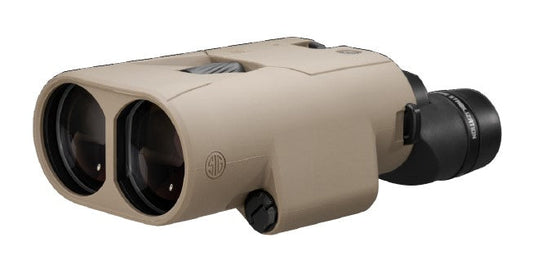

Sig Sauer ZULU6 HDX Pro 16x50mm Binoculars provide a high-performance solution for long-distance viewing. Equipped with OmniScan technology, these binoculars minimize image shake, making it easier to spot wildlife or distant objects. The user-selectable modes, including Scan Mode and Target Mode, allow for flexible viewing tailored to your specific needs, enhancing stability and detail during observation.
Featuring HDX-Glass, these binoculars achieve up to 25% better light transmission, ensuring bright and clear images, even in low-light conditions. Weighing 33.91 oz and boasting an IPX-7 waterproof rating, the ZULU6 is built to withstand various outdoor environments. With these binoculars, you'll experience exceptional clarity and reliability on your outdoor adventures.
Key Features:
- OMNISCAN TECHNOLOGY for outstanding image stabilization, reducing hand tremors when spotting targets.
- USER SELECTABLE MODES allow for tailored viewing experiences with Scan and Target Modes.
- HDX-GLASS ENHANCEMENT improves light transmission by up to 25% for brighter, clearer images.
- IPX-7 WATERPROOF RATING ensures durability in wet conditions, making them perfect for outdoor adventures.
- LIGHTWEIGHT DESIGN at 33.91 oz ensures portability, allowing for all-day use without fatigue.
- WIDE ANGULAR FIELD of view at 3.7° for comprehensive observation of expansive landscapes.
- OPTIMAL EYE RELIEF of 16.4mm provides comfort for extended glassing sessions.
- NEW METAL BATTERY CAP enhances durability and longevity for seamless functionality.
Technical Specifications Table
| Specification | Details |
|---|---|
| Magnification | 16x |
| Lens Diameter | 50mm |
| Weight | 33.91 oz |
| Dimensions | 8" x 4.79" x 2.63" |
| Eye Relief | 16.4mm |
| Angular Field of View | 3.7° |
| Twilight Factor | 28.3 |
| Interpupillary Distance | 56mm - 72mm |
What’s in the Box?
- Sig Sauer ZULU6 HDX Pro 16x50mm Binoculars
- Carrying Case
- Lens Covers
- Neck Strap
Customer Reviews
"These binoculars are a game changer for my birdwatching trips! The image stabilization is incredible!"
"I'm impressed by the clarity and light transmission; perfect for dawn and dusk!"
FAQ
1. How does the image stabilization work?
OmniScan technology intelligently adjusts stabilization levels based on your movement, providing smooth, clear views even when moving.
2. Are these binoculars suitable for low-light conditions?
Yes! The HDX-Glass enhances light transmission, making them ideal for dawn and dusk observations.
3. Can I use these binoculars for general wildlife observation?
Absolutely, with the user-selectable modes, they're perfect for both wide area scanning and detailed target identification.
4. What kind of maintenance do these binoculars require?
Regularly wipe the lenses with a microfiber cloth, and store them in the provided case to keep them in top condition.
5. How do they compare to other brands?
The ZULU6 stands out with its advanced stabilization technology, high-quality optics, and robust waterproof design, making it a top choice among enthusiasts.
Similar Models
If you're looking for more exceptional optics, check out our range of Sig Sauer products. Explore the Sig Sauer ZULU5 for a compact option or the Sig Sauer ZULU9 for even higher magnification. Discover the full collection today, tailored to enhance your outdoor adventures.
You May Also Like
Here’s some of our most similar products people are buying. Click to discover trending style.






